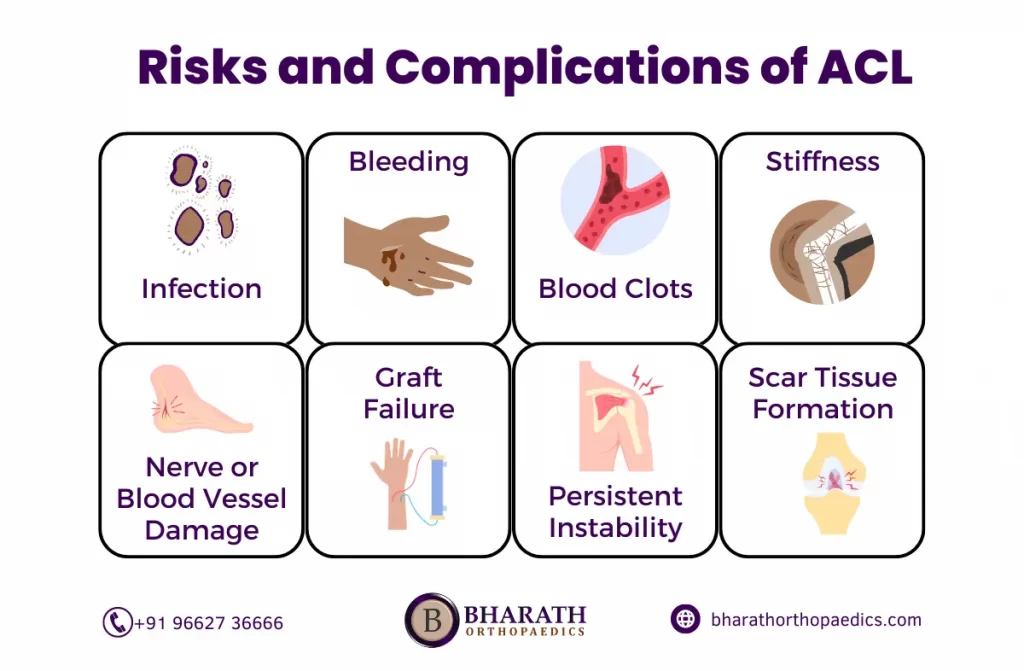When it comes to knee injuries, an anterior cruciate ligament (ACL) tear can be particularly debilitating. ACL surgery in Chennai is often the recommended course of action to restore stability and functionality to the knee joint. In this article, we will explore the key aspects of ACL surgery, including pre-surgery preparations, surgical techniques, post-operative care, and the crucial rehabilitation process. By understanding what to expect and how to optimize your recovery, you can enhance your chances of a successful outcome and regain an active and pain-free lifestyle at the best ACL surgery cost in Chennai.
What is ACL Surgery?
ACL (Anterior Cruciate Ligament) surgery is a procedure to reconstruct or repair a torn ACL in the knee. The ACL is crucial for stabilizing the knee joint during activities like pivoting or jumping. Surgery typically involves using graft tissue, often from the patient’s own body or a donor, to reconstruct the ligament. This procedure is performed arthroscopically, using small incisions and specialized instruments to minimize trauma. Post-surgery, physiotherapy treatment is crucial to regain strength, stability, and range of motion in the knee. ACL surgery aims to restore knee function and stability, allowing individuals to return to sports and daily activities effectively.
ACL reconstruction is a vital surgery for those who have experienced a torn anterior cruciate ligament. It’s essential for restoring knee stability and function. In Chennai, many people search for the Best ACL reconstruction in Chennai to ensure they receive top-notch care. In this article, we will explore the process, cost, and recovery of ACL reconstruction, along with identifying the Best ACL reconstruction in Chennai. Whether you’re concerned about the ACL reconstruction surgery cost in Chennai or want to find the Best ACL reconstruction in Chennai, we will provide all the necessary information to help guide your decision.

Types of ACL surgery
There are primarily two types of ACL (Anterior Cruciate Ligament) surgery based on the source of the graft used for reconstruction:
- Autograft ACL Surgery:
- Patellar Tendon Autograft: The middle third of the patellar tendon, along with bone blocks from the patella and tibia, is harvested and used as the graft.
- Hamstring Tendon Autograft: The tendons of the hamstring muscles (gracilis and semitendinosus) are harvested and used as the graft.
- Quadriceps Tendon Autograft: A portion of the quadriceps tendon, along with its patellar bone block, can be used as an alternative autograft option.
- Allograft ACL Surgery:
- Tissue grafts sourced from a human donor (cadaver) are used for ACL reconstruction. Common allograft options include patellar tendon, hamstring tendon, or Achilles tendon grafts.
Each type of ACL surgery has its advantages and considerations, including graft strength, healing time, and risk of graft rejection or infection. The choice of graft type often depends on factors such as patient age, activity level, surgeon preference, and the specific characteristics of the ACL injury.
Benefits of the ACL Surgery
ACL (anterior cruciate ligament) surgery offers several benefits, including:
- Stability Restoration: Surgery stabilizes the knee joint, preventing instability and reducing the risk of recurrent injuries.
- Improved Function: Restoring the ACL enhances joint function, promoting better mobility and agility.
- Pain Reduction: Surgery often alleviates pain associated with ACL injuries, improving overall quality of life.
- Return to Activities: It facilitates a return to sports and other physical activities with reduced risk of re-injury.
- Preventive Measure: ACL surgery can prevent long-term joint damage and reduce the likelihood of developing osteoarthritis.
- Enhanced Quality of Life: Overall, ACL surgery aims to improve the patient’s quality of life by addressing pain, instability, and limitations in physical activities.
Finding the Best ACL Reconstruction in Chennai
For a successful surgery and faster recovery, it is crucial to choose the Best ACL Reconstruction in Chennai. Look for the following when selecting a hospital or surgeon:
- Experience and Expertise – Ensure the surgeon has performed multiple successful ACL reconstructions.
- Advanced Techniques – Hospitals with minimally invasive surgical options reduce recovery time.
- Post-Surgery Rehabilitation – Comprehensive physiotherapy programs enhance healing.
- Patient Reviews – Feedback from previous patients helps in making an informed decision.
ACL Reconstruction Surgery Steps
The ACL reconstruction procedure is a well-established method to restore knee stability after an injury. Below are the main steps involved in the surgery:
- Anesthesia and Preparation: The patient is put under general anesthesia. The surgeon marks the surgical site, and sterile drapes are applied to maintain a clean environment during the procedure.
- Incision and Arthroscopy: Small incisions are made around the knee to insert an arthroscope. This allows the surgeon to view the inside of the knee joint on a monitor.
- Removal of Damaged Tissue: The torn ACL is carefully removed, and any damaged tissue is cleaned.
- Graft Placement: A graft, often taken from the patient’s own tendon or a donor tendon, is used to reconstruct the ACL. It is fixed to the bone using screws or other fixation devices.
- Closing the Incisions: After the graft is placed, the incisions are closed using sutures. A bandage is applied to reduce swelling.
The ACL surgery cost in Chennai depends on factors like the hospital and type of graft used, but the procedure ensures optimal outcomes for those seeking the Best ACL Reconstruction in Chennai.
Indications for ACL Reconstruction
ACL reconstruction is recommended for individuals who experience:
- Severe knee instability affecting daily activities.
- Persistent pain and swelling despite conservative treatments.
- Inability to participate in sports or physical activities.
- Associated knee injuries like meniscus tears.
- Young and active individuals requiring full knee function.
Choosing the Best ACL Reconstruction in Chennai ensures that patients receive advanced surgical techniques and post-operative care for a successful recovery.
Surgical Techniques
Several techniques can be used in ACL surgery depending on the extent of the injury:
- Autograft: Tissue is taken from the patient’s own body (usually the hamstring or patellar tendon) to reconstruct the ACL.
- Allograft: Tissue from a donor is used, which may be preferable for some patients.
- Minimally invasive techniques: Arthroscopic surgery involves smaller incisions, reducing recovery time.
- Computer-assisted surgery: Advanced technology ensures precise alignment, improving the long-term outcome of the reconstruction.
Each technique has its advantages, and your doctor will recommend the most suitable option for your specific case of ACL surgery in Chennai.
Choosing the Right ACL Surgery Doctor
When selecting an ACL Surgery doctor in Chennai, it’s essential to consider their qualifications, experience, and patient-centered approach to care. An ideal doctor for ACL reconstruction should have:
- Extensive training in orthopedics and specialization in knee surgeries, including ACL reconstruction.
- Experience in advanced ACL surgical techniques that focus on minimally invasive methods for reduced recovery time.
- A track record of successful surgeries, with a history of positive patient outcomes and testimonials.
- Clear communication and guidance through pre-operative planning and post-operative rehabilitation.
Choosing the right specialist significantly impacts recovery, and a top-notch surgeon will ensure that you have a clear understanding of your procedure, post-surgery care, and what to expect during rehabilitation. Patients are encouraged to look for certified and reputed ACL surgery doctors in Chennai with a patient-first approach for the best results.
ACL Surgery Doctor in Chennai
Dr. L. Bharath
Dr. L. Bharath, a distinguished orthopedic surgeon at Bharath Orthopaedics, is widely recognized for his expertise in ACL Surgery in Chennai. With an MBBS, MS in Orthopedics, and FRCS from the UK, Dr. Bharath combines extensive academic knowledge with hands-on experience in performing complex knee surgeries, including ACL reconstruction surgery. His approach to ACL surgery is both comprehensive and patient-centered, ensuring that every individual receives a tailored treatment plan. Known for using advanced surgical techniques, he emphasizes minimally invasive procedures that minimize recovery time and improve patient outcomes.
- Years of Experience: Over 20+ years
- Qualifications: MBBS, MS (Orthopaedics), DNB (Orthopaedics)
- Available Time: Mon-Sat 9 am to 8 pm | Sun – 10 am to 3 pm
- Address: Flat-A Ground Floor , Balaji Villa, New Door No.38/1, Old Door No.9/1, Rajaratnam Street, Kilpauk, Chennai-600010.

Conclusion
Choosing the best ACL surgery in chennai at a reasonable ACL surgery cost in Chennai maximizes the chances of a successful outcome. By partnering with a skilled orthopedic surgeon like Dr. L. Bharath from Bharath Orthopaedics, you can regain strength, stability, and functionality in your knee during the healing process. Furthermore, patience, dedication, and working closely with your healthcare team will help you achieve the best ACL reconstruction in Chennai. Trust an experienced ACL surgery doctor in Chennai to help you get back to an active and fulfilling life.
Read also Recovery from Hip Replacement.
